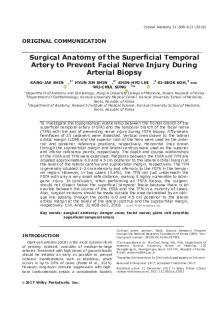CS8491 CA - Lecture notes 5 PDF

| Title | CS8491 CA - Lecture notes 5 |
|---|---|
| Author | Dharunya Santhosh |
| Course | Mobile Computing |
| Institution | Anna University |
| Pages | 2 |
| File Size | 73.3 KB |
| File Type | |
| Total Downloads | 85 |
| Total Views | 150 |
Summary
notes...
Description
CS8491
COMPUTER ARCHITECTURE
L 3
T P 0 0
C 3
OBJECTIVES: • To learn the basic structure and operations of a computer. • To learn the arithmetic and logic unit and implementation of fixed-point and floating point arithmetic unit. • To learn the basics of pipelined execution. • To understand parallelism and multi-core processors. • To understand the memory hierarchies, cache memories and virtual memories. • To learn the different ways of communication with I/O devices. UNIT I BASIC STRUCTURE OF A COMPUTER SYSTEM 9 Functional Units – Basic Operational Concepts – Performance – Instructions: Language of the Computer – Operations, Operands – Instruction representation – Logical operations – decision making – MIPS Addressing. UNIT II ARITHMETIC FOR COMPUTERS Addition and Subtraction – Multiplication – Division – Floating Point Representation – Floating Point Operations – Subword Parallelism
9
UNIT III PROCESSOR AND CONTROL UNIT 9 A Basic MIPS implementation – Building a Datapath – Control Implementation Scheme – Pipelining – Pipelined datapath and control – Handling Data Hazards & Control Hazards – Exceptions. UNIT IV PARALLELISIM 9 Parallel processing challenges – Flynn‘s classification – SISD, MIMD, SIMD, SPMD, and Vector Architectures - Hardware multithreading – Multi-core processors and other Shared Memory Multiprocessors - Introduction to Graphics Processing Units, Clusters, Warehouse Scale Computers and other Message-Passing Multiprocessors. UNIT V MEMORY & I/O SYSTEMS 9 Memory Hierarchy - memory technologies – cache memory – measuring and improving cache performance – virtual memory, TLB‘s – Accessing I/O Devices – Interrupts – Direct Memory Access – Bus structure – Bus operation – Arbitration – Interface circuits - USB. TOTAL :
45
PERIODS
OUTCOMES: On Completion of the course, the students should be able to: Understand the basics structure of computers, operations and instructions. Design arithmetic and logic unit. Understand pipelined execution and design control unit. Understand parallel processing architectures. Understand the various memory systems and I/O communication. TEXT BOOKS: 1. David A. Patterson and John L. Hennessy, Computer Organization and Design: The Hardware/Software Interface, Fifth Edition, Morgan Kaufmann / Elsevier, 2014. 2. Carl Hamacher, Zvonko Vranesic, Safwat Zaky and Naraig Manjikian, Computer Organization and Embedded Systems, Sixth Edition, Tata McGraw Hill, 2012.
REFERENCES: 1. William Stallings, Computer Organization and Architecture – Designing for Performance, Eighth Edition, Pearson Education, 2010. 2. John P. Hayes, Computer Architecture and Organization, Third Edition, Tata McGraw Hill, 2012. 3. John L. Hennessey and David A. Patterson, Computer Architecture – A Quantitative Approach‖ , Morgan Kaufmann / Elsevier Publishers, Fifth Edition, 2012....
Similar Free PDFs

CS8491 CA - Lecture notes 5
- 2 Pages

Convertidores ca ca - Nota: 5
- 3 Pages

Ca - Notes
- 10 Pages

5 - Lecture notes 5
- 4 Pages

Ca - notes
- 6 Pages

Chua vs CA - Lecture notes Sales
- 1 Pages

Pf2 chap 5 en ca - Pf2 chap 5 en ca
- 63 Pages

Ca CO3 HCl - Lecture notes 1
- 2 Pages

Chapter 5 - Lecture notes 5
- 15 Pages

Chapter-5 - Lecture notes 5
- 6 Pages

Chapter 5 - Lecture notes 5
- 83 Pages

Tutorial 5 - Lecture notes 5
- 3 Pages

Chapter 5 - Lecture notes 5
- 4 Pages

Imagen 5 - Lecture notes 5
- 1 Pages
Popular Institutions
- Tinajero National High School - Annex
- Politeknik Caltex Riau
- Yokohama City University
- SGT University
- University of Al-Qadisiyah
- Divine Word College of Vigan
- Techniek College Rotterdam
- Universidade de Santiago
- Universiti Teknologi MARA Cawangan Johor Kampus Pasir Gudang
- Poltekkes Kemenkes Yogyakarta
- Baguio City National High School
- Colegio san marcos
- preparatoria uno
- Centro de Bachillerato Tecnológico Industrial y de Servicios No. 107
- Dalian Maritime University
- Quang Trung Secondary School
- Colegio Tecnológico en Informática
- Corporación Regional de Educación Superior
- Grupo CEDVA
- Dar Al Uloom University
- Centro de Estudios Preuniversitarios de la Universidad Nacional de Ingeniería
- 上智大学
- Aakash International School, Nuna Majara
- San Felipe Neri Catholic School
- Kang Chiao International School - New Taipei City
- Misamis Occidental National High School
- Institución Educativa Escuela Normal Juan Ladrilleros
- Kolehiyo ng Pantukan
- Batanes State College
- Instituto Continental
- Sekolah Menengah Kejuruan Kesehatan Kaltara (Tarakan)
- Colegio de La Inmaculada Concepcion - Cebu

